Japan
Wood Products Prices
Dollar Exchange Rates of 10th
June
2025
Japan Yen 144.20
Reports From Japan
US tariffs continue to disrupt trade
Japan's exports fell in the first 20 days of May as sweeping
US tariffs continued to disrupt trade. May exports,
measured by value, dropped 3% year on year according to
the Ministry of Finance. That compared with a 2.3% rise
in the first 20 days of April and a 2.0% rise for all of of
April. Japan's trade balance for the period was in deficit
for around US$8 billion.
See:https://www.japantimes.co.jp/business/2025/06/06/economy/
early-may-japan-exports-drop/
‘Real’wages declined for a fourth consecutive month
The latest data shows real wages in Japan declined for a
fourth consecutive month in April according to the
Ministry of labour as pay increases continued to fall
behind price rises.
On an inflation-adjusted basis, wages were down 1.8% in
April year on year with the inflation figure for that month
estimated at 4.1%. Households are suffering from rising
food prices, especially for rice prices which were up 98%
year on year in April.
The government has been pushing for pay hikes to support
consumer spending, a key driver of economic growth,
recently setting a goal of achieving real wage growth of
around 1 percent across Japan, including through massive
public-private investment, by fiscal 2029.
See:
https://mainichi.jp/english/articles/20250605/p2g/00m/0bu/0160
00c
In recognition of the issue of slow wage growth the
government has highlighted wage increases as a
cornerstone of its economic growth strategy according to a
draft of its planned basic policy on economy, public
finances and reform.
In a draft presented to the Council on Economic and Fiscal
Policy, wage increases are a key part of its growth
strategy.
See: https://www.nippon.com/en/news/yjj2025060601091/
Inflation deters discretionary spending
Household spending declined in April as inflation deterred
discretionary spending. Outlays by households, adjusted
for inflation, fell 0.1% from a year earlier according to the
Ministry of Internal Affairs and Communications. The
decline was led by health care and miscellaneous
spending, while outlays jumped almost 11% for housing.
The importance of consumer spending as an engine of
growth in Japan has increased as US tariffs have dented
export prospects.
Domestic demand will likely be a key factor in
determining whether Japan can avoid a technical recession
after the economy shrank in the first quarter 2025.
See:
https://www.japantimes.co.jp/business/2025/06/06/economy/japa
n-household-spending-falls/
Births at historical low
Japan's fertility rate declined in 2024 for the ninth
consecutive year, reaching another historical low that
underscores the immense challenge facing the government
as it attempts to reverse the trend in one of the world’s
most aged societies.
The total number of births dropped to about 686,000
marking the first time the figure has fallen below 700,000
extending the run of annual declines in the country’s
population to 18 years. The data exclude migration.
The data underscore the urgency of the government’s
recent push to boost fertility which include a range of
policies aimed at easing the financial burden on families.
The government has also guaranteed full wage
compensation for some couples who both take parental
leave. Also the government has promoted improved
working conditions for childcare and nursing staff.
The continued decline in births is renewing concern over
the future of Japan’s social security system. The nation’s
public pension programme is under increasing strain with
fewer contributors and a growing number of recipients.
Over the past two decades, the number of people paying
into the system has fallen by around 3 million, while
beneficiaries have increased by nearly 40%.
The labor market is also expected to remain under
pressure. If current trends continue, Japan could face a
shortage of 6.3 million workers in 2030, according to an
estimate by Persol Research and Consulting.
See:
https://www.japantimes.co.jp/news/2025/06/04/japan/fertility-
rate-low/
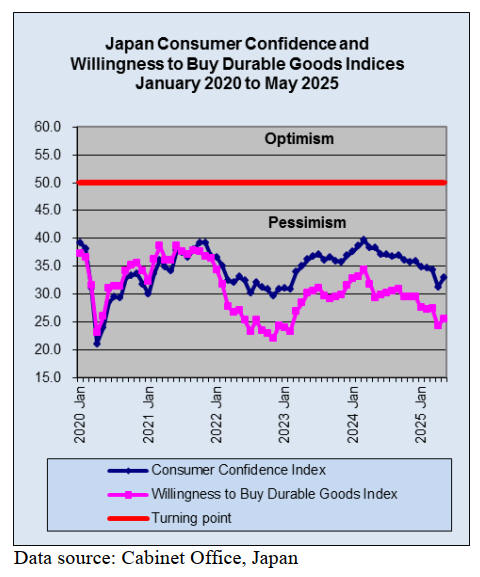
BoJ advised to continue with monetary tighteneing
The U.S. Treasury has suggested the Bank of Japan (BoJ)
should continue with monetary tightening in response to
domestic economic fundamentals including growth and
inflation to achieve “normalisation of the yen’s weakness”
and rebalance of bilateral trade.
The explicit mention of Japan’s monetary policy signals
the US focus on the BoJ’s ultra-low interest rate which is
seen as among factors that have kept the yen weak against
the dollar.
The US Treasury also said in its judgement no major US
trading partner was found manipulating its currency in
2024. But it said Japan, as well as China, South Korea,
Taiwan P.o.C, Singapore, Viet Nam, Germany, Ireland
and Switzerland, were on its monitoring list for extra
scrutiny.
The BoJ ended its massive monetary stimulus last year and
in January raised short-term interest rates to 0.5% given
the indications were that a durable 2% inflation rate was
possible.
The slow pace at which the BoJ is raising interest rates has
been seen by markets as a key factor keeping the yen weak
against other currencies.
See: https://www.asahi.com/ajw/articles/15825625
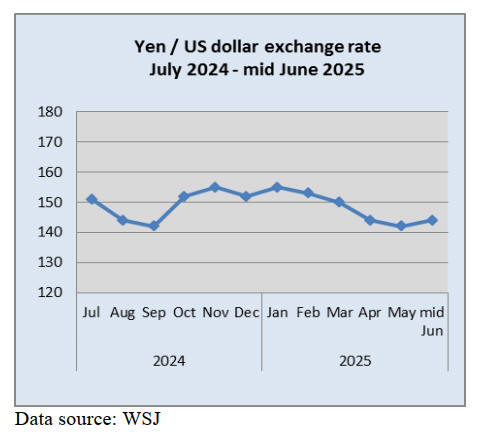
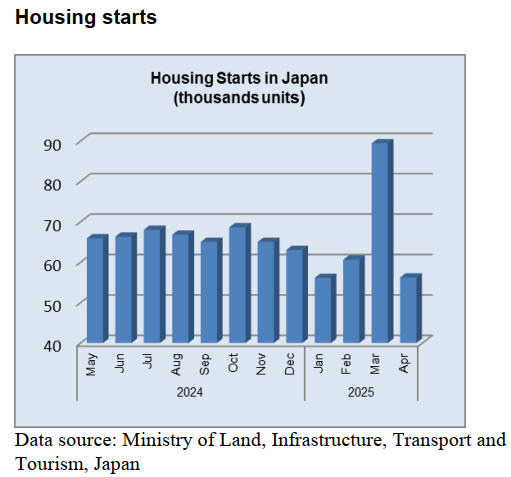
More than US$230 billion in M&A last year
With ample cash and trading at low valuations Japanese
companies are becoming more adept at defending against
rivals and activist investors who are showing renewed
interest in the country after decades of stagnant growth.
With changing attitudes on business expansion M&A is
expected to rise with analysts expecting a busier 2025 after
more than US$230 billion in M&A last year.
See:
https://www.japantimes.co.jp/business/2025/01/09/companies/ja
pan-ma-boom/
Japan, a leading contributor to the Africa Development
Fund
Cooperation between Japan and India is emerging as an
important dynamic in promoting development in African
nations. Representatives from the private sector,
government and academia gathered in Tokyo earlier this
year for a Japan-India-Africa Business Forum.
Marie-Laure Akin-Olugbade, Senior Vice President at the
African Development Bank, said Japan is a leading
contributor to the Bank’s Africa Development Fund which
extends assistance to 37 low-income nations in Africa.
She also mentioned Japan’s US$5 billion contribution over
the three years to 2025 to the Bank’s Enhanced Private
Sector Assistance for Africa initiative which funds
advances in electricity, connectivity, health, agriculture
and nutrition.
See: https://ps.asia.nikkei.com/jia2025/index.html
Import update
Assembled wooden flooring imports
The main category of assembled flooring imports in April
2025 was HS441875, accounting for 75% (62% in March)
of the total value of assembled flooring imports compared.
Of HS441875 imports, 69% was provided by shippers in
China, 15% by shippers in Viet Nam and 12% by shippers
in Malaysia. The other main source of assembled flooring
(HS441875) in April was Thailand.
The second largest category in terms of value in April
2025 was HS441873 (15% of the total in April) all of
which was shipped from China. The third and fourth
largest categories in value terms were HS441879 (8%) and
HS441874 (2%).
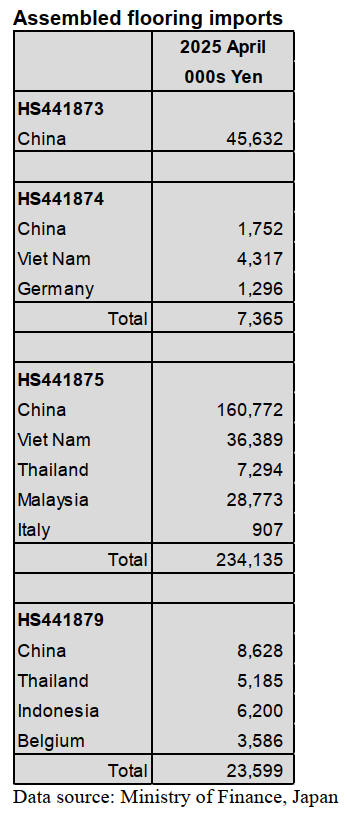
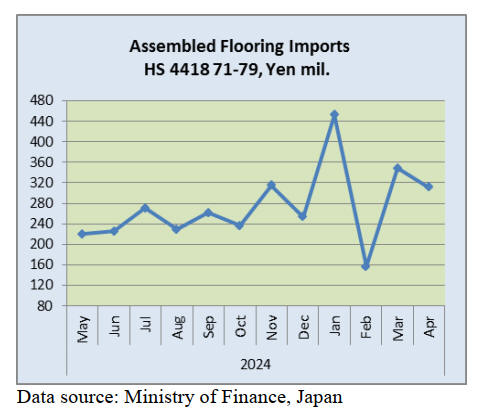
Plywood imports
As activity in the building and construction sectors gained
momentum in April demand for plywood increased. In
April 2025 arrivals of HS441210-39 were up 12% month
on month and also 8% higher than the arrivals in April
2024.
Malaysia and Indonesia were the top suppliers in April, as
in previous months. The volume of imports from Malaysia
rose slightly while the import volumes from Indonesia
were flat. Compared to past years, the volumes of plywood
imported into Japan have been steadily falling as more
plywood manufactures in Japan utilise domestic logs.
In April 2025 the other main shippers were Viet Nam and
China. Arrivals from China in April were down compare
to a month earlier while arrivals from Viet Nam were little
changed month on month.
As in previous months, of the various categories of
plywood imported in January 2025 HS441231 was the
largest (87% of total imports) followed by HS441233 and
HS441234 (5% each). The balance was of HS441239.
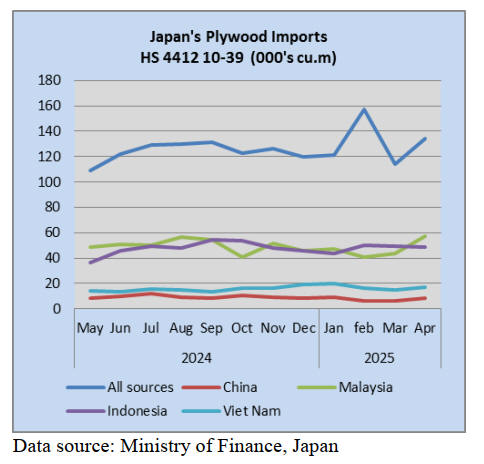
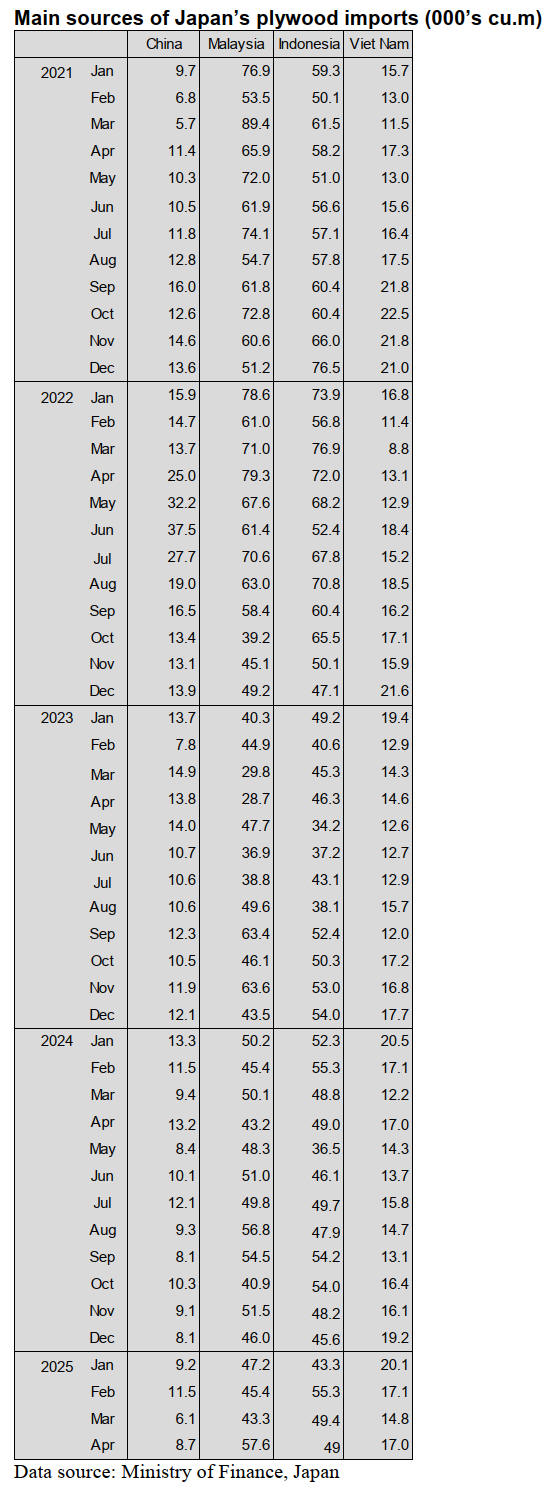
Trade news from the Japan Lumber Reports (JLR)
The Japan Lumber Reports (JLR), a subscription trade
journal published every two weeks in English, is
generously allowing the ITTO Tropical Timber Market
Report to reproduce news on the Japanese market
precisely as it appears in the JLR.
For the JLR report please see:
https://jfpj.jp/japan_lumber_reports/
First JAS certification for plywood in Viet Nam
United Forest Co., Ltd. became the first plywood plant in
Viet Nam to obtain JAS certification for plywood as of
the 5th May, 2025. Going forward, the company aims to
expand its customer base, targeting both building material
manufacturers and general distribution channels.
The JAS certification was obtained for standard plywood
manufactured at a plywood plant in Tuyen Quang
Province, Viet Nam, using all-layer Styrax Type 2. The
plant is able to produce medium-thickness standard
plywood that is commonly distributed in Japan.
Since all-layer Styrax has a white appearance and is
exceptionally beautiful, it was deemed easy to propose to
building material manufacturers using Chinese poplar
plywood, leading to the decision to obtain JAS
certification. The company started an operation at the
plant in the second half of 2023 and currently, 3,000 cubic
meters of plywood are being produced per month.
The majority of sales are directed toward factories of
Japanese furniture manufacturers in North America and
Viet Nam, with some sales also going to Japanese
building material manufacturers.
In addition to Styrax, the plant also uses Acacia and
Eucalyptus as raw materials. The plant also produces
birch plywood for the U.S. market and is capable of
complying with FSC certification requirements.
The LVL factory in Phu Tho Province, Viet Nam,
produces 2,500 cbms per month, with 2,000 cbms
allocated for the Japanese market. The plant has also
obtained JAS certification for LVL used in joinery
applications. Previously, there were two plants, but
operations were consolidated, leading to the closure of
one factory in the latter half of 2023.
In addition to considering an increase in production
capacity, the company is also planning a new LVL factory
within a nearby industrial park
The movement of South Sea a Chinese lumber is sluggish
due to low demand. Since the yen had appreciated against
the dollar in April, 2025 some companies had emerged
that is moving to secure only the necessary amount for the
immediate needs.
Furthermore, since mid-May, the exchange rate has shifted
back toward yen depreciation, prompting moves to secure
the necessary amount for immediate needs. Even though
the movement of goods is weak, there is still a certain
level of demand.
In Indonesia, orders for laminated boards from
manufacturers, which manufacture furniture for the U.S. in
Indonesia, decreased due to the additional tariff by the
U.S. government. It could also impact the sales approach
for laminated boards in the Japanese market.
Also, Chinese manufactures struggle with the same
situation. However, due to the persistently high prices of
raw materials such as Russian red pine, there is a strong
stance on maintaining the current pricing.
South Sea logs from Papua New Guinea have arrived as it
was scheduled in April, 2025. Demand and supply of
South Sea logs are balanced. Although the local weather
remains stable, the global demand for South Seas log
timber is slowing due to the deteriorating economic
outlook in China.
Logs destined for Japan are selected from high-quality
materials originally intended for China. Since the decrease
in shipments to China directly affects the supply to Japan,
concerns are being raised about its potential impact.
New wooden board - an alternative to tropical
hardwoods
Daiken Corporation in Osaka Prefecture announced that its
subsidiary, Daiken North America Ltd. in Canada, had
successfully completed the prototype of a new wooden
board that had been under development. It is expected to
be used as a baseboard for flooring, as an alternative to
tropical hardwoods and temperate broadleaf (birch)
plywood. Moving forward, the company plans to refine
the production line and improve quality with commercial
production scheduled for spring 2026.
The name of the new wooden board is “DIO woodcore”.
At the NWFA Expo, the largest exhibition in the wood
flooring industry, held in North Carolina, USA the
company showcased flooring samples made using this
product as the base material. It is said to achieve
performance equivalent to plywood in terms of bending
strength, wood screw retention and surface smoothness.
The material used is aspen one of the sustainable resources
native to Canada. Daiken North America is a manufacturer
of low-melamine decorative panels using particle board as
the base materia, with an annual production capacity of 7
million square metres.
Special feature, ‘Laminated lumber and CLT’
According to a survey regarding to production of
laminated structural lumber, which was held by Japan
Forest Products Journal in April, 2025, of the 42 valid
responses, 29 (accounting for 69%) indicated an expected
increase in production for 2025 compared to the previous
year (including those projecting the same production level
as the previous year).
Nine responses indicated a decrease compared to the
previous year, accounting for 21% of the valid responses.
This represents a four-point increase from last year's 17%.
Compared to last year, the shift in demand away from
imported laminated wood and competing Douglas fir
lumber has stabilised. In a demand environment where an
increase in housing starts is also unlikely, more
manufacturers are presenting a bleak outlook.
The production-related survey was conducted among 127
domestic laminated wood and CLT manufacturers
certified under JAS. Valid responses were received from
60 businesses, including 42 regarding laminated structural
lumber, 19 regarding laminated decorative lumber and 8
regarding CLT.
In 2024, the production volume of structural laminated
wood saw 15 responses indicating an increase compared to
the previous year (including those expecting the same
level as the previous year), accounting for 36% of valid
responses. This represents an 18-point decrease from last
year's survey result of 54%. Last year's survey responses
indicated that 81% of valid responses expected an increase
in production volume for 2024. However, it appears that
many manufacturers struggled more than anticipated to
achieve growth.
In the second half of 2023, the domestic inventory of
imported laminated lumber declined, leading to increased
demand for domestically produced products. Additionally,
from autumn onward, substitute demand emerged to
compensate for the shortage of Douglas fir lumber.
Additionally, manufacturers handling medium- and large-
section laminated lumber saw demand related to the
Osaka-Kansai Expo. These special factors supporting
demand continued until the spring of 2024. As the impact
weakened toward the summer, this change was reflected in
the survey results.
Regarding this year's production volume, 12 responses
indicated an expected increase compared to the previous
year (including those expecting the same production level
as last year). This accounted for 63% of valid responses,
marking a 21-point increase from last year's 42%.
In the survey on CLT manufacturers, 53 out of 59 valid
responses (accounting for 90%) indicated that some costs,
such as labor or logistics expenses, increased in 2024. 47
responses, accounting for 80%, indicated that the cost
increases would continue in 2025.
However, only nine responses indicated that the increased
costs had been passed on to product prices, with progress
ranging from 1% to 50%, highlighting the challenges of
price increases. Additionally, regarding logistics issues in
2024 beyond cost increases, nine responses indicated
difficulties in dispatching trucks due to shortages, while
three responses noted a reduction in transportation routes
for heavy goods and small-lot shipments.
In 2024, 42 manufacturers experienced an increase in
labor costs. The reasons for the increase were as follows:
12 responses cited base salary increases, 9 mentioned
regular wage increases, and 4 indicated workforce
expansion and measures against rising prices.
There were 44 responses indicating an increase in logistics
costs. The reasons for the increase were as follows: 19
responses cited higher freight charges, 6 pointed to the
2024 logistics issue, and 3 mentioned rising fuel prices.
There were 35 responses indicating an increase in
electricity costs. There were 42 responses indicating an
increase in adhesive costs. 18 manufacturers of structural
laminated lumber and CLT manufacturers responded that
lamina costs had increased. 15 responses indicated an
increase in log costs. For 2025, more responses indicated
that costs would remain flat compared to 2024. Eight
manufacturers of decorative laminated wood responded
that veneer and decorative sheet costs had increased.
The outlook for cost increases in 2025 was indicated as
follows: 39 responses for labor costs, 30 each for logistics
and electricity costs, 25 for adhesives, 22 for 22 for
lamina, 13 for logs, and 6 for veneers and decorative
sheets.
|